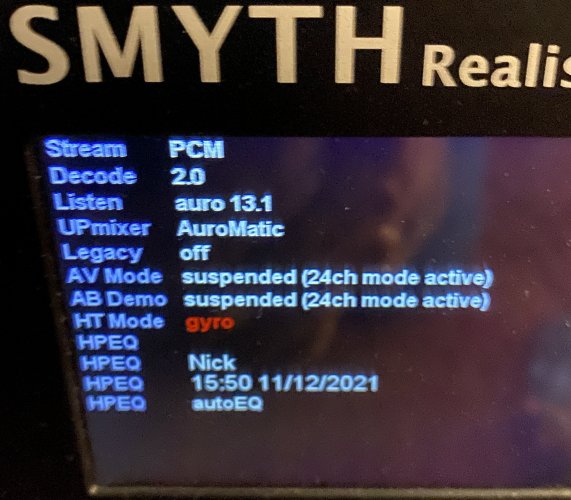GU1DO
1000+ Head-Fier
- Joined
- Sep 20, 2015
- Posts
- 1,233
- Likes
- 538
i am drooling over your demo descriptionThere are people in this thread that have experienced the demo, or own a Realiser A8, and will vouch for how well the Realiser works. Of course in theory you can never be sure of someone's objectivity but if you read in this thread I hope you get the feeling you can trust at least some of the people here. If you google for reviews of the A8 you will find a few and what is said in those will be a good indication for what the A16 is capable of.
I have expierenced a demo myself in Munich Germany last May, and I assure you I have no affiliation with Smyth, and nothing to gain by lying or exaggerating about this, this is what I experienced:
It is really hard to tell the difference between the real speakers and the simulated speakers. Initially when I first heared the sound over headphones I had to ask if I was really hearing the headphones and not the speakers. Like the first guy in the video of Munich 2016. In fact I could tell the difference at some moment, but only because there was a slight level mismatch (the simulation over headphones was a tiny bit louder or softer - I don't remember which of the two, and I think there was a ever so slight difference in sound colour but maybe I imagined that - possibly as a result of the small volume difference. I think this was caused by the fact that the headphone during the HPEQ measurement was a little bit out of the optimal position on my head, and hence in a different position than during the rest of the demo. This year they used a Stax instead of the Sennheisser they used in 2016 in Munich, and this Stax tended to sit a little bit to low on my head. Luckily this doesn't affect the PRIR measurement that was made, the HPEQ I have to do again at home anyway with my own headphones.) But the feeling of hearing speakers was 100% convincing. It is a strange feeling: it is as if the headphones on your head have nothing to do with the sound you hear, it feels like the sound is coming from outside, from the speakers. I have never experienced something like this before. (I have listened to samples of DTS Headphone X for example: there you sometimes think a sound comes a little more from the front of your head, or a little bit more from the back, nothing more, it stil is practically in your head or a little bit around, and could never for a millisecond be mistaken for sound coming from speakers or other sources far outside of your head.) After the measurement they first one by one let each of the speakers play alone, and let you compare the sound of that speaker with the sound over the headphones. Over the headphones the sound just seemed to stil be coming out of that speaker, and seemed to have nothing to do with the headphones on my head.
Like Fox1977 I also witnessed other people getting the demo so I witnessed that indeed the speakers were not playing when they put on the headphones. Another guy waiting to get the demo was present in the room during my demo, I thought I had noticed a Dutch accent so I asked him in Dutch (I'm Dutch also): "They are not fooling me are they? The speakers are really quiet when I put the headphones on?" and he confirmed that.

i hope it meet my expectations specially after a very detailed post like yours,
thanks for sharing your experience.




















 )
)